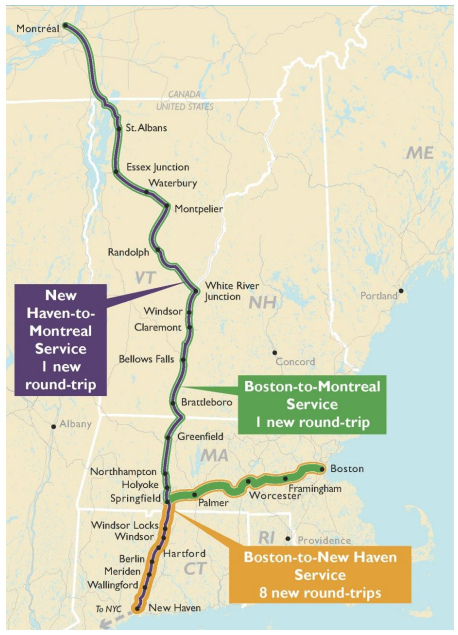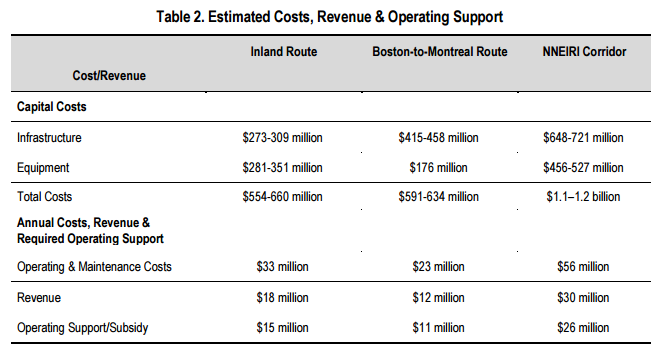Politicians in the Pioneer Valley really want more intercity rail coming through the region. At an MPO meeting that I wrote about several months back, Mayor Sarno of Springfield commented that building an east-west rail link to Boston would open up the city’s affordable housing stock to Boston, which has a housing affordability crisis. Meanwhile, north-south rail improvements would improve access to Hartford, New York City, and Montreal, better integrating Springfield into an interior northeastern route. These same sentiments were described more fully in a recently released report, Northern New England Intercity Rail Initiative (NNEIRI) Study.

And it’s true, right now rail options suck in the Pioneer Valley. We have the Lake Shore Limited, which goes east-west one time per day, and the Vermonter which goes north-south one time per day. Even though both these routes could serve commuters traveling between Worcester and Springfield, or Hartford and Springfield, the schedule makes them useless to anyone other than an intercity traveler.
Writing about rail transportation in Springfield, I am reminded of a few years ago when Chris Leinberger, a real estate expert, came to visit Springfield and provide thoughts about how to improve the economic performance of the city. A point he hit a couple of times was that we have got to build a streetcar; the city would be transformed by it. Score another endorsement for rail!
What’s amazing to me is the persistent dedication people have to rail transportation, despite the fact that it has so many apparent disadvantages relative to rubber-tire service. In brief:
- It is really expensive. The proposed track upgrades to connect Boston to New Haven via Springfield would be at least $554 million, not counting operating costs (see table below); this route would need to be subsidized at $145 per trip, which doesn’t include capital costs. As for streetcars, the most celebrated American streetcar in Portland, Oregon cost several hundred million dollars to construct and carried 3.9 million riders last year. Meanwhile, the top-of-the-line bus rapid transit line in Cleveland cost only $50 million, and boasts 5 million trips per year.
- Also, it’s really expensive. The cost of riding the train from Springfield to New York, for example, is $47 and takes 3.5 hours (depending on freight traffic). The cost of taking a bus is $27 and takes 3.5 hours (depending on highway traffic). So it gets you there no faster, though is nearly twice as expensive.
- Did I mention that it’s expensive? It’s usually more expensive than we expect. Planning studies for rail projects tend to have ridership projections that are too high and capital cost estimates too low (also known as The Pickerell Effect). A good example is Albuquerque’s Rail Runner commuter rail, which has continued to underperform in ridership since it started service in 2007.

The reality is that bus transportation, while not as efficient at moving people as rail, tends to be much more flexible and affordable. So why are elected officials stuck on rail? I have a few theories:
- It’s undeniably sexy. Even Ayn Rand made the main character of her celebration of fierce individualism and greed, Atlas Shrugged, a railroad tycoon. There’s something about the iron horse which connotes power, industry, and sophistication (while a bus brings up images of people coughing, yelling, and spilling Big Gulps on you).
- It’s expensive. Yes, I realize that I listed that as a drawback. But one person’s expense is another’s income. I wonder if the high price tag does not in fact invigorate elected officials to embrace rail because it will do what every elected official wants – it will create jobs! Just this past week, Massachusetts mucky mucks were in Springfield to celebrate the completion of the factory that is going to manufacture new $2 million subway cars for the MBTA.
- It’s perceived to be an economic development engine, probably for two reasons. First, it attracts higher-income riders, and in so doing funnels these high-earners into a narrow corridor that businesses want to occupy. Second, it cements the route to a particular corridor, whereas bus routes could change at any point. Although, in the case of the DC streetcar, the economic development transformation took root well before the streetcar was finished – suggesting that we should just announce streetcars and then never actually build them. Hmm… developers might eventually catch on.
I guess I’ll close by pointing out that I’m not necessarily anti-rail. I would love to be able to hop on a high-speed train to get down to New York City in 90 minutes, or down to Washington in four hours. But I am a strong proponent of using tax dollars wisely. And for the most part, rail just doesn’t seem to pencil out when driving is so cheap and easy.
So who knows, maybe someday I’ll take one of the added trains on the Inland Route to get to Boston or New York City from Springfield. Honestly, I’d be happy to do so. Until then I’m content hopping a Peter Pan bus and working my crosswords as the road passes by my window. At $27, that’s not too bad.
